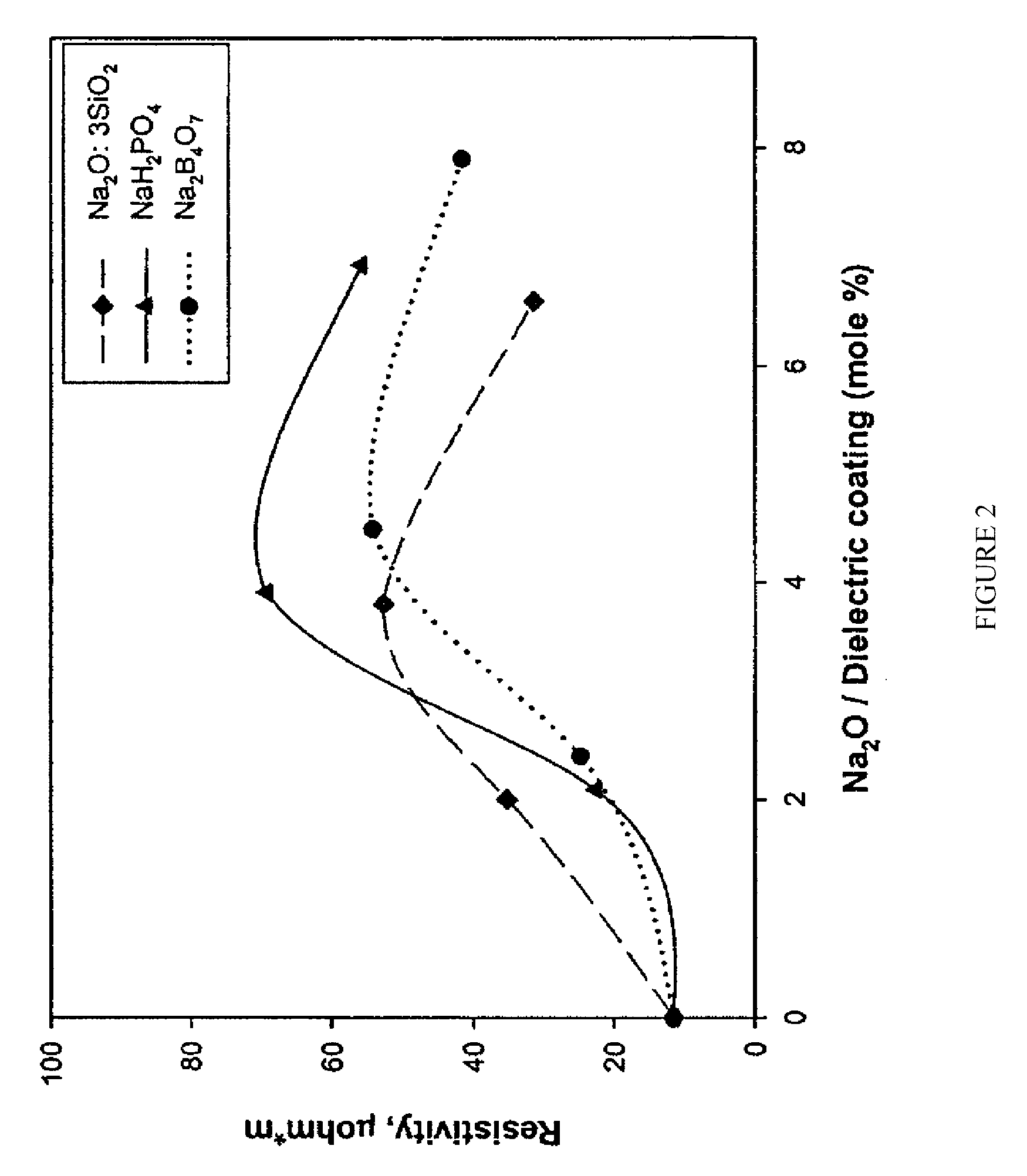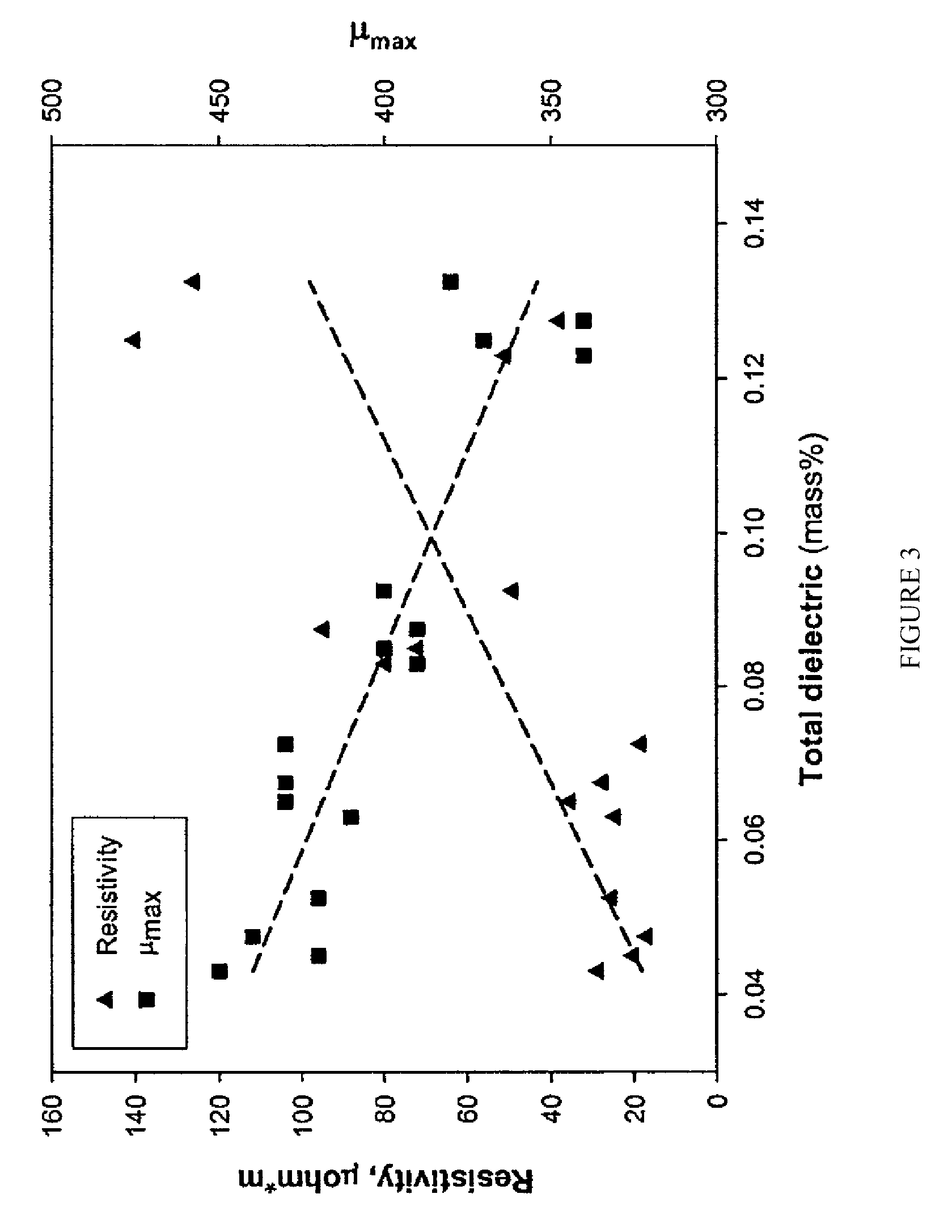Insulated iron-base powder for soft magnetic applications
a soft magnetic and iron-base technology, applied in the field of ferromagnetic powders, can solve the problems of reducing the magnetic properties of the material, reducing the acoustic noise, and producing a certain amount of scrap, so as to achieve the effect of reducing the losses and significantly increasing the electric resistivity
- Summary
- Abstract
- Description
- Claims
- Application Information
AI Technical Summary
Benefits of technology
Problems solved by technology
Method used
Image
Examples
example 1
Effect of the Relative Proportion of Alkali Compound
[0043]In this example, the ferromagnetic powder used is the high purity ATOMET® 1001 HP iron powder with a particle size ranging from 5 μm up to 250 μm. Two base solutions were prepared: solution A containing 6 grams of boric acid H3BO3 (Borax Optibor grade) in 100 ml of ethanol or 6% (m / v) and solution B containing 3 grams of the alkali compound Na2B4O7*10H2O in 100 ml of water (Borax Decahydrate) or 3% (m / v).
[0044]From these base solutions, four reaction solutions were prepared by combining 10 ml of solution A to 0, 1, 2 or 4 ml of solution B. Four coated iron powders or samples were prepared by mixing one kilogram of ATOMET® 1001 HP iron powder with each of the reaction solutions (10 to 14 ml solution / kg of iron). After coating, the powders were dried at 100° C. for 60 minutes, mixed with 0.5% Kenolube lubricant and pressed at 690 MPa into rectangular test bars (31.7 mm long×12.7 mm wide×6.35 mm thick) and magnetic core rings (5...
example 2
Effect of the Nature of the Alkali Compound
[0048]In this example, it is demonstrated that good results can also be obtained by using other alkali compounds such as, alkali phosphates and alkali silicates, in which cases binary and ternary glass compositions are obtained. Different reaction solutions were prepared by mixing solution A containing 6% (m / v) boric acid (H3BO3) in ethanol with various alkali 3% (m / v) solutions such as Na2B4O7*10H2O (from Borax), Na2O:3SiO2 (from PQ Corporation) or NaH2PO4*2H2O (from Fisher Scientific) in water solutions named respectively solution B (from Example 1), C and D. In the three types of coating, Na is the alkali element, B is the major glass former element and P or Si are minor glass modifiers which change slightly the structure of the borate glass network. The three formulations of coated iron powders were prepared by mixing one kilogram of ATOMET® 1001 HP iron powder with 10 ml of the boric acid solution and 0, 1, 2 or 4 ml of each alkali sol...
example 3
Alkali Borate Coating Process
[0054]In this example, the variability of the process is demonstrated for an alkali borate glass coating formulation. For this purpose, 20 samples of 500 g were prepared using ATOMET® 1001 HP as the base iron powder and a wet-coating process according to the following steps. Different base solutions were prepared: 5% and 10% (m / v) boric acid H3BO3 (Borax Optibor grade) in ethanol and 2% and 5% (m / v) of the alkali compound Na2B4O7*5H2O (sodium tetraborate pentahydrate) in water. The solutions were mixed together in different proportions and sprayed onto the iron powder and homogenized during 30 minutes in a laboratory blender. The coated powders were dried at 100° C. for one hour and mixed with 0.45% Kenolube. Rectangular bars and magnetic core rings were pressed at 690 or 830 MPa and heat-treated at 500° C. for 30 minutes in air. Density, transverse rupture strength and resistivity were measured on the rectangular bars while the magnetic properties were ...
PUM
| Property | Measurement | Unit |
|---|---|---|
| thickness | aaaaa | aaaaa |
| size | aaaaa | aaaaa |
| size | aaaaa | aaaaa |
Abstract
Description
Claims
Application Information
 Login to View More
Login to View More - R&D
- Intellectual Property
- Life Sciences
- Materials
- Tech Scout
- Unparalleled Data Quality
- Higher Quality Content
- 60% Fewer Hallucinations
Browse by: Latest US Patents, China's latest patents, Technical Efficacy Thesaurus, Application Domain, Technology Topic, Popular Technical Reports.
© 2025 PatSnap. All rights reserved.Legal|Privacy policy|Modern Slavery Act Transparency Statement|Sitemap|About US| Contact US: help@patsnap.com



